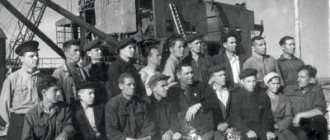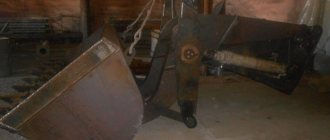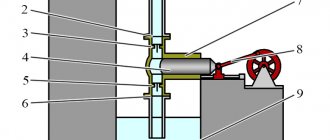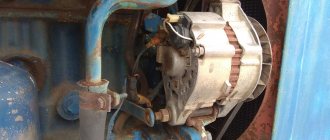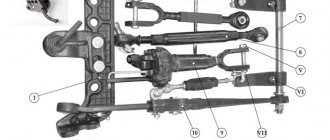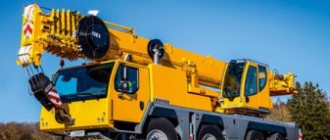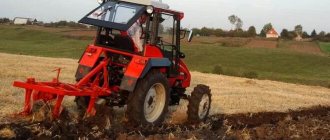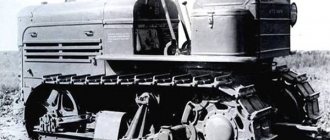Depending on their functional purpose, tractor trailers are produced in different formats and configurations. Moreover, each exhibit has its own PTS (vehicle passport), so before you buy this or that model, it’s a good idea to inquire about its technical characteristics.
For example, a universal model called a tractor dump semi-trailer has an onboard platform. Increasing the sides makes it possible to use such devices when transporting agricultural products or building materials.
Application
In agriculture, a tractor tipper semi-trailer can transport:
- all types of fertilizers;
- containers with liquids;
- bulk substances.
Specialized tractor dump semi-trailers are sometimes extremely necessary. However, narrow specialization turns a narrow-profile unit into a complex and expensive product. It is not always economically rational to use such mechanisms.
The following are also considered specialized equipment:
- trailers for transporting agricultural equipment (tractors, combines);
- transportation of cattle.
Trailers have rotating devices, so the issue of unloading bulk products in this case is easier to solve. Such designs are easier to work with, they are more functional and reliable. Trailers with swivel mechanisms are often found in mountainous areas where high stability is required.
In addition, the semi-mounted tractor chassis trailer is suitable for mounting special equipment.
Constructions
Tractor dump semi-trailer is differentiated into the following types:
- standard semi-trailer;
- full-fledged models;
- semi-mounted representatives.
The design of the trailer is made in such a way that the weight of the transported material is evenly distributed over two axles and a hydraulic hook. In tractor devices, the main load falls on the hydraulic trailer hook and the axle, which is located at the rear.
In semi-mounted equipment, the load is evenly distributed on the axle and the hydraulic trailer hook of the unit. One of the main advantages of these models is also that they connect to each other. Thus, it is possible to configure the device at your discretion.
Road trains in which several elements are involved. Most often in agriculture you can see harvesting machines that work in conjunction with loading trailers.
Main modifications
The most popular representatives of towed devices are the following:
- Tractor trailer 2 PTS 4 is equipped with a loading platform. There are hydraulic lifts that tilt in three directions. Specially designed for transporting bulk or solid loads other than cobblestones or rock formations.
- Tractor trailer with index 2 PTS 2 and model 4 5. Special equipment is suitable for driving in field conditions, and is also intended for all types of roads. Extension sides are all-metal or mesh.
- Tipper tractor semi-trailer with the name pst 6. Suitable for transporting construction materials, root crops, grain, fertilizers, and other goods. The unit is distinguished by a rear beveled side and two side hydraulic cylinders, which guarantee quick loading and unloading, since the fall height is no more than 20 cm.
Technical characteristics 2 PTS-4
The body length is 6.3 meters and the width is 2.57.
It should be noted that the high metal sides have stiffening ribs. These mechanisms are designed for tractors that have hydraulic pneumatic systems. The weight of the cargo reaches five tons. Special equipment has the following types of units:
- welded frame;
- swivel mechanism;
- axles with suspensions;
- platform tipping hydraulic unit;
- brake block.
If a tractor dump semi-trailer receives the heaviest load on the frame, then the following forces are at work:
- static loads;
- dynamic loads;
- twisting forces.
A mechanical impulse occurs during movement or braking. In semi-trailers, the frames are reliable relative to twisting forces. Some elements (tanks, grain bodies) take on part of the large loads, thereby slightly reducing the load on the frame.
Vibrators also provide great assistance in unloading tractor trailers, as they effectively “shake” the contents of the body.
Floating conveyor PTS-4 - video
PTS-4 was created by specialists from OJSC KBTM from the city of Omsk. In 2014, the company was renamed OJSC Omsk Transport Engineering Plant. This vehicle was first shown to the public at an exhibition of weapons and military equipment in Omsk in 2007. In 2011, the floating tracked transporter successfully passed state tests. The vehicle was accepted for supply to the Russian armed forces and is mass-produced in Omsk.
PTS-4 was created to replace the outdated floating transporters PTS-2 and PTS-3, which were produced in the USSR in the 1970s and 1980s. Their production was established in Lugansk on the chassis of T-64 tanks from the Kharkov Transport Engineering Plant. The design of the chassis of the new PTS-4 uses elements of mass-produced main battle tanks: T-80 tracks and torsion bars, T-72 gearbox and clutches. The mass of this tracked floating vehicle is 33 tons, which is comparable to the weight of 7 African elephants. Despite its considerable weight, the car feels great both in the field and in the pond, demonstrating an excellent level of buoyancy. The maximum speed on the highway is 60 km/h, afloat - 15 km/h. The vehicle's carrying capacity is 18 tons, and its cruising range (in terms of fuel) on land is 587 km.
Currently, floating tracked transporters PTS-4, which are produced in Omsk at the transport engineering plant, are considered the best in their class. At the Army-2015 military-technical forum held this summer in the Moscow region, the PTS-4, which is in service with the engineering units of the Russian army, was shown for the first time. The “Four” was created with extensive use of components and assemblies of the T-72 and T-80 tanks. This transporter is designed for crossing various types of military equipment through various water obstacles: cars, towed artillery, armored personnel carriers and infantry fighting vehicles. Also, floating conveyors can be used during various rescue operations during natural disasters, for example, during river floods. The crew of the car consists of two people. The weapon used is a remote-controlled large-caliber 12.7 mm machine gun. According to some military experts, in the near future, it is possible that a new floating tracked transporter will appear using components of the promising heavy tracked platform "Armata".
The PTS-4 tracked amphibious transporter can not only transport military equipment, personnel and various cargoes across water obstacles, but also transport these cargoes in swampy or rough terrain, which makes the vehicle quite versatile. True, this significantly reduces the carrying capacity of the tracked conveyor. The tracked transporter can also be used in amphibious assault operations. For this purpose, additional equipment is specially installed on it: two pumps designed to pump out water with a capacity of 800 and 400 liters per minute, special glazing protection, a sealed awning, exhaust extensions and a gyro-semi-compass. The floating conveyor PTS-4 can be used for its intended purpose in sea conditions of up to 5 points.
Taking into account that the plant in Omsk received the task of developing a fifth-generation transporter, in the process of creating PTS-4 a very large amount of research and experimental work was carried out, which included the search for the most rational and effective technical solutions, as well as their subsequent processing and run-in. In particular, issues of the size and shape of displacement hulls were worked out, various types of propulsors, conveyor control systems afloat, sump pumps, and the like were examined. Significant attention of the developers was paid to increasing the maneuverability of the new tracked conveyor, especially at the stage of the vehicle entering the water and exiting the water onto land. The roll angle was increased to 25 degrees, and the angle of ascent/descent overcome was increased to 32 degrees.
Unlike the vehicles of its predecessors, the same PTS-3, the new amphibious conveyor has become 8 tons heavier due to an increase in carrying capacity and the appearance of armor that meets modern requirements. In particular, the PTS-4 control department received bulletproof armor. Thanks to the use of a new design engine, it was possible to increase the speed of movement of the floating conveyor both on land and on the water surface. And the increased fuel reserve allows the transporter to cover a significantly greater distance on one refueling. For self-defense, a remote-controlled heavy machine gun was installed on the tracked transporter.
The medium floating tracked transporter PTS-4 was created to replace outdated transporters in service with the Russian army, and also due to the fact that all production of these combat vehicles since the times of the USSR ended up on the territory of Ukraine (Lugansk). All PTS transporters of previous series were produced on the chassis of the T-64 main battle tank, which was also manufactured at a Ukrainian enterprise (Kharkov). The new PTS-4 transporter is based on the chassis of the T-80 tank and is entirely manufactured by Russian enterprises from Russian components.
The crawler amphibious conveyor consists of a watertight body with a crew cabin and a cargo compartment, which has a hinged tailgate. The engine is located approximately in the central part of the conveyor body, which increases its stability afloat and the reliability of transmission of torque to the water and tracked propulsion systems, as well as to the winches. On PTS-4, the developers abandoned the location of the propellers in the tunnels and installed them in special guide nozzles, which were installed behind the rear of the vehicle. At the same time, a dual water rudder appeared behind each of the propellers. Thanks to the presence of these design solutions, it was possible to increase the maneuverability and controllability of the PTS-4 afloat, especially when the conveyor moves along curved trajectories. When turning afloat using rudders, the circulation radius of the PTS-4 is approximately 80 meters, and when turning in the propeller operating mode in counterpropulsion, it is approximately 20 meters. While the crawler is moving over land, the propellers are raised and pressed against the tailgate. When lowering and raising the rear side, the propulsion-steering complex moves along with the side.
The floating conveyor is unloaded and loaded on land through a folded tailgate, which is equipped with ramps. The equipment comes on board under its own power. Non-self-propelled military equipment is moved using a special mechanical winch, which is located in front of the transporter’s cargo platform. This winch can also be used for self-pulling the PTS-4 in a situation where the coastal topography does not allow the conveyor to go ashore (in this case, unloading the vehicle becomes much more complicated and the time required for this operation increases). Structurally, the engineers provided for the possibility of simultaneous crossing of the tractor and the artillery system towed by it, which in this case is loaded onto a floating wheeled trailer, which is included in the PTS-4 kit. In this case, maneuverability and speed of movement drop significantly (by almost 30%).
The floating transporter PTS-4 has an armored crew cabin, which is equipped with a filter and ventilation unit. The machine also has a device for self-digging. Technically, it is possible to install mounted shielding of the chassis on the conveyor. The cockpit contains communications equipment, as well as equipment that allows the vehicle to be driven even at night and in poor visibility.
It is worth noting that PTS-4 has already been repeatedly used during rescue operations in flood zones both in our country and in a number of other countries. With the help of these machines, the evacuation of the civilian population, property, and livestock from flooded areas was organized, as well as the establishment of a supply of water and food to the population, and the provision of first aid in areas that were cut off by the flood.
Semi-trailers
This type of transport is connected to the tractor using a saddle assembly and a device called a “hydraulic hook”. These elements can effectively improve traction and grip characteristics.
Such semi-trailers stand out for their excellent dynamics and maneuverability. They weigh a third less than a standard tow hitch and are easier to use. A tractor with a semi-trailer has great advantages over a full-fledged heavy trailer.
It is also possible to attach several more of the same mechanisms to the semi-trailer. For example, PST-12 (12 dump semi-trailer) is one of the best mechanisms of this class. It is capable of carrying twelve tons of cargo. Body volume reaches more than 14.6 cubic meters. The unit is used in field work. Works with 2.0 TC tractors.
Additionally, the design is equipped with a screw element, which mechanizes the filling and unloading of bulk products.
Performance characteristics of 12 PST
- Weight 1.51 tons;
- Semi-trailer weight 323 kg;
- Tractor power 14-42 hp;
- Dimensions (if you consider the drawbar in the lowered form) (LxWxH) 3247x1552x1224 mm;
- Body size inside: 1912x1472x310 mm;
- The height of the sides without extensions is 305 mm;
- The side can be increased up to 524mm;
- Can be driven by a hydraulic system;
- Elevation angle 56 degrees;
- Ground clearance 314 mm;
- Axles 1 pc.;
- The suspension is hard;
- Parameters of the coupling loop DxS 32x34 mm;
- Speed up to 26 km/h;
- Minimum operating pressure in the hydraulic system, MPa 1.11;
- Maximum operating pressure in the hydraulic system, MPa 2.1.
The following are the characteristics of 2 PTS 4 5
PPTS-5 - tractor dump semi-trailer
The vehicle is distinguished by a chassis made in the form of a two-axle twin bogie, shifted to the rear of the platform. In the improved modifications, a chassis design with independent suspension on each side was introduced, in the form of a swinging trolley with a pair of wheels on separate springless consoles. The advantage of this design is the distribution of weight between the trailer wheels and the rear drive wheels of the tractor, which provides additional load when driving on moist soils in field conditions and difficult dirt roads. Unlike 2PTS-4, the semi-trailer does not have a turning mechanism, which provides a more rigid frame structure. A natural disadvantage of a two-axle semi-trailer is the increased lateral load on the chassis when making sharp turns and turns. Unloading is carried out on three sides, the braking system receives air drive from the tractor.
PPTS-5
PPTS-5 unloading on the side
| Name | Meaning | Value with extensions |
| Trailer weight, kg | 1750 | — |
| Weight of transported cargo, tons | 5 | |
| Maximum speed, km/h | 35 | |
| Trailer dimensions length/width/height, mm | 5645/2835/1800 | 5645/2835/2280, with mesh extensions-5645/2835/2850 |
| Internal body size length/width/height, mm | 4090/2230/620 | 4090/2230/1100, with mesh extensions – 4090/2230/1620 |
| Body volume, m³ | 5,65 | 10,03 mesh attachments -14.78 |
| Loading height in the platform no more than, mm | 1180 | |
| Track, mm | 1800 | |
| Ground clearance, mm | 350 | |
| Pressure in the hydraulic system, mPa | 15-20 | |
| Brakes | Single-line pneumatic | |
| Parking brakes | Mechanical drive | |
| Electrical equipment | Single-wire with 12V voltage from the tractor network | |
| Tires | 13.0-16 model VL38 | |
| Lifting angle back/to the side, degree | 50/45 | |
| Number of cylinder sections | 3 | |
| Working stroke of hydraulic cylinder, mm | 1350 | |
Semi-mounted devices
A semi-mounted trailer is the same two or three-axle mechanism. The mass here transfers from the front axle to the hydraulic hook and chassis. Thus, the coefficient of adhesion with the tractor increases , and the overall load capacity increases.
Freight road trains significantly increase productivity and can replace several dump trucks. Moreover, performance is limited by the permissible maximum axle loads.
The connection point of the frame itself is pushed forward. The weight is distributed between the cart and the tractor. This helps to increase grip and traction capabilities. When compared with a trailer, a semi-trailer has a carrying capacity that is on average one third higher.
Performance characteristics of PTS-4
Seats in the cabin, pcs.: 2
Weight PTS-4
— 33,145 tons
Load capacity of PTS-4
— on land: 12 tons — on water and approaches to water obstacles: 18 tons
PTS-4 speed
Maximum speed, km/h: - on land: 60 - on water: 15
Dimensions of PTS-4
Dimensions of the cargo platform, mm: - length: 8280 - width: 3300
Engine PTS-4
— engine power, hp: 840
Fuel range:
— on land, km: 587 — on water, h: 10.6
Armament PTS-4
Closed anti-aircraft gun: - caliber, mm: 12.7 - ammunition, pcs: 400


